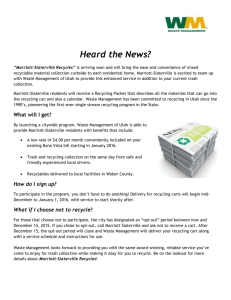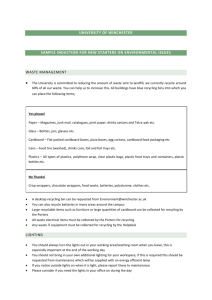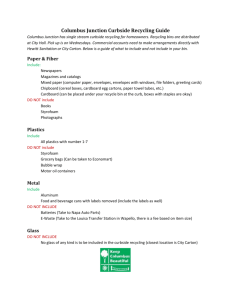Thank you for your participation to help reduce waste and improve
advertisement
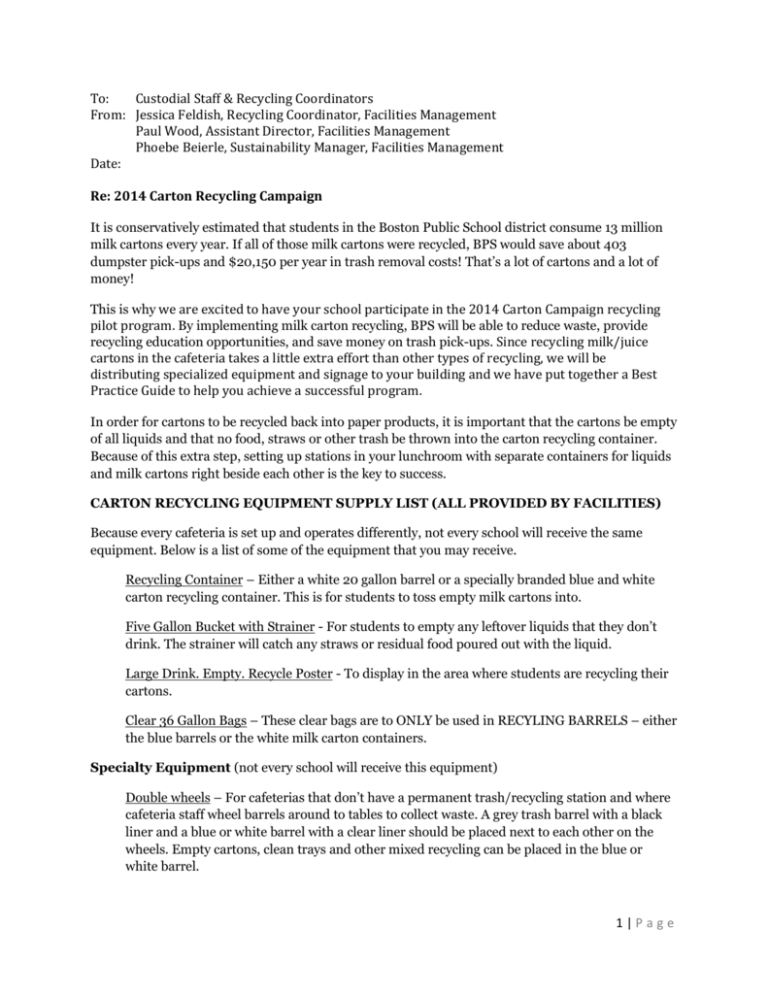
To: Custodial Staff & Recycling Coordinators From: Jessica Feldish, Recycling Coordinator, Facilities Management Paul Wood, Assistant Director, Facilities Management Phoebe Beierle, Sustainability Manager, Facilities Management Date: Re: 2014 Carton Recycling Campaign It is conservatively estimated that students in the Boston Public School district consume 13 million milk cartons every year. If all of those milk cartons were recycled, BPS would save about 403 dumpster pick-ups and $20,150 per year in trash removal costs! That’s a lot of cartons and a lot of money! This is why we are excited to have your school participate in the 2014 Carton Campaign recycling pilot program. By implementing milk carton recycling, BPS will be able to reduce waste, provide recycling education opportunities, and save money on trash pick-ups. Since recycling milk/juice cartons in the cafeteria takes a little extra effort than other types of recycling, we will be distributing specialized equipment and signage to your building and we have put together a Best Practice Guide to help you achieve a successful program. In order for cartons to be recycled back into paper products, it is important that the cartons be empty of all liquids and that no food, straws or other trash be thrown into the carton recycling container. Because of this extra step, setting up stations in your lunchroom with separate containers for liquids and milk cartons right beside each other is the key to success. CARTON RECYCLING EQUIPMENT SUPPLY LIST (ALL PROVIDED BY FACILITIES) Because every cafeteria is set up and operates differently, not every school will receive the same equipment. Below is a list of some of the equipment that you may receive. Recycling Container – Either a white 20 gallon barrel or a specially branded blue and white carton recycling container. This is for students to toss empty milk cartons into. Five Gallon Bucket with Strainer - For students to empty any leftover liquids that they don’t drink. The strainer will catch any straws or residual food poured out with the liquid. Large Drink. Empty. Recycle Poster - To display in the area where students are recycling their cartons. Clear 36 Gallon Bags – These clear bags are to ONLY be used in RECYLING BARRELS – either the blue barrels or the white milk carton containers. Specialty Equipment (not every school will receive this equipment) Double wheels – For cafeterias that don’t have a permanent trash/recycling station and where cafeteria staff wheel barrels around to tables to collect waste. A grey trash barrel with a black liner and a blue or white barrel with a clear liner should be placed next to each other on the wheels. Empty cartons, clean trays and other mixed recycling can be placed in the blue or white barrel. 1|Page Plastic Utility Cart – The cart can be used to collect clean, stacked trays and/or hold the bucket and strainer to collect excess liquid. Empty cartons can also be collected on the bottom shelf of the cart in a milk crate or other plastic bin. CARTON RECYCLING CAFETERIA EQUIPMENT SET UP These guidelines will help ensure that cafeteria recycling is free of food contamination and other garbage. For schools with wall space available to set up a sorting station: A trash and recycling station should have a designated area so students must disassemble their food trays in the following order: 1. 2. 3. 4. 5. Signage – Carton recycling and single stream recycling signs should be hung in appropriate places and kept consistent each day. A Bucket/Container for Leftover Liquids - Students must empty their residual milk/juice into this container. Recycling Container - Students should then toss their empty milk or juice carton into the designated carton container or into a blue barrel with mixed recycling. Garbage can - Students must empty all food waste and trash into the grey garbage can. Desk/Table or Cart – Students should stack CLEAN trays on a table. The stacked trays can be transferred to the big blue carts for recycling. DIRTY trays can also be stacked to save space, but be sure to keep the stacks separate. For schools with limited wall space and/or moving trash receptacles: Facilities will provide a utility cart on wheels and/or a set of double wheels to be placed in a strategic location in the lunchroom with the same materials as above placed on or next to the cart. 2|Page After meals for all schools: The below steps after meals will ensure that your program will run smoothly behind the scenes. 1. The residual liquids bucket should be emptied before it gets too heavy to lift. 2. The carton recycling container may have to be emptied after breakfast, in between meal periods, or after lunch. 3. All residual liquid buckets and strainers should be emptied and rinsed at the end of the day. Recycling containers should be rinsed as needed. 4. Mixed recycling from the cafeteria should be transferred loosely to the blue carts. If possible, identify a few blue carts just for cafeteria recycling and try to store them outside as the cartons and trays are more prone to smell. OTHER TIPS: 1. It is important that a student, volunteer, parent or someone from the custodial or cafeteria staff monitor the recycling station the first week of the program launch to make sure all students are recycling their cartons correctly. 2. If your containers have a plastic liner to hold the cartons, do not place this plastic liner in the recycling container. Place it in the garbage. Cartons and trays must be loose in the blue recycling carts so that they have a chance to air-dry. We want to hear from you about what is working at your school. Please direct all helpful tips, photos, student leadership stories, etc., to Jessica Feldish, District Recycling Coordinator for Boston Public Schools (jfeldish@bostonpublicschools.org). Thank you for your participation to help reduce waste and improve our school environments! 3|Page
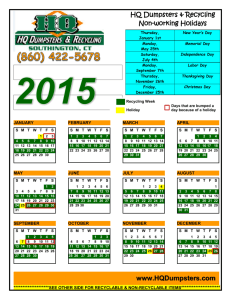


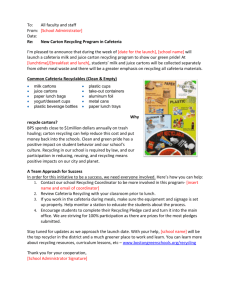

![School [recycling, compost, or waste reduction] case study](http://s3.studylib.net/store/data/005898792_1-08f8f34cac7a57869e865e0c3646f10a-300x300.png)
